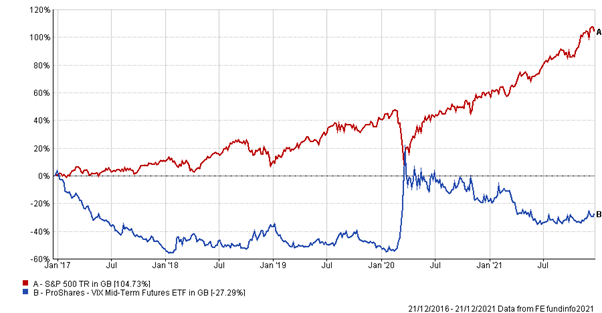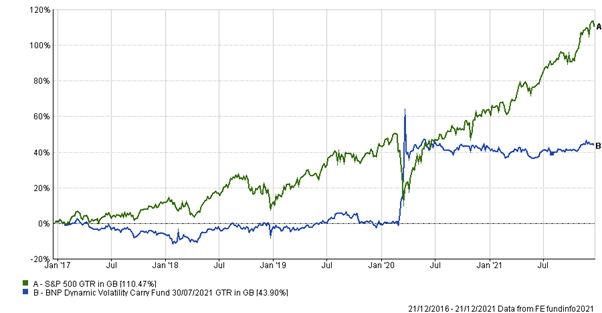The nature of risk
Stock markets are inherently risky. Whilst equities have historically provided the best returns over the long term, they can be extremely volatile.
According to analysis by Compound Capital Advisers, 10% drops in the US stock market (the S&P 500) happen around every 1.6 years on average; 15% drops happen every 2.5 years; 20% drops every 4 years; and 30% drops happen every 9 years.
In our portfolios, we want to have some decent exposure to equities to acquire growth, whilst also looking for ways to hedge the risk of sharp falls.
The best way to hedge equity risk is via diversification, investing in lots of different assets like bonds or property, as well as stocks. However, in the recent era of quantitative easing and low interest rates, we are concerned that some of these assets might be more correlated in certain circumstances. With this in mind, let’s look at some of our alternative solutions to hedge our equity risk.
‘Put’ up your money
One of the most common strategies for hedging equity risk is to buy a put option.
Buying a put option gives you the right (but not the obligation) to sell at a fixed price in the future, at a fixed point in time.
For example, we could take out a put option that gives us the right to sell the FTSE 100 at 6,500 in December 2022. As I am writing this, the FTSE is at around 7,500 so this option is certainly “out of the money”, i.e., much further away than the sell level of the option.
Conversely, the option would become valuable should the market drop below 6,500. Let’s assume the market drops to 6,000 on December 2022. We could then exercise our option to sell at 6,500, roughly 8.3% above the actual market level. We make a gain on the put option which offsets some of the losses on our equity holdings, thus an effective hedge.
A put option is a bit like an insurance contract in that it will only be worth anything in a particular set of circumstances. To purchase the option, we must pay an “insurance premium.” If the market doesn’t fall below 6,500, the insurance policy expires without paying out and we’ve paid all the premium for nothing (although we’ve hopefully made a decent gain on our equity holdings).
Take car insurance for instance, you hope your policy never needs to pay out. However, it’s a little frustrating to have paid out all that money to get nothing in return. And of course, the insurance company calculates the level of the premiums, so they nearly always win! They work out how many times they will have to pay out in a given period, how much this will cost them, and then calculate how much the premiums should be so they make a profit in pretty much every circumstance.
It is no different with a put option. The premiums can be expensive and, in many ways, it’s better to be the insurance company, than it is the person buying the insurance – more to come on that later….
Betting on volatility
Another potential way of hedging equity is to bet on volatility going up.
The Chicago Board Options Exchange (CBOE) calculates an index known as the VIX. It is derived from the price of S&P index options. The more volatile the market, the more people are willing to pay for options and so the VIX increases when volatility goes up.
When markets drop sharply, meaning volatility has increased, so too does the VIX index. The VIX often moves in the opposite direction to the stock market, however, it’s not a perfect relationship. Volatility can increase if the market rises sharply and it’s also possible that markets could slowly grind lower, in a uniform way. That being said, most of the time, betting on volatility to increase will be a decent hedge against sharp market falls.
There are several ways you can essentially track the VIX index just as you can track an equity index. For example, there are ETFs (Exchange Traded Funds) that track the index, or you can buy options on the VIX.
Chart one: Comparison of VIX ETF (blue) and the S&P 500 (red) – 5-year period

Warning: Undefined array key "caption" in /srv/users/equilibrium-dev/apps/equilibrium-dev/public/wp-content/themes/equilibrium/partials/image-block.php on line 4
Like a put option, you might be grateful to own this product at certain times, such as in March 2020, when the S&P 500 fell very sharply. During this period, you would have made a very sharp return on the VIX ETF.
Both put options and VIX strategies can help hedge your risk against a sharp fall in stocks.
However, like the put option, buying the VIX (blue line) means most of the time you make a loss. In fact, you would have lost over 27% had you held this ETF for this whole 5-year period.
A third way…
There is a third way of hedging equities which essentially combines elements of the above two strategies.
Remember earlier, when I said that it is often better to be the insurance company than it is to buy the insurance policy?
Well, the Dynamic Volatility Carry Strategy (catchy name!) from BNP Paribas essentially acts just like the insurance company. The fund SELLS put options to other investors and collects the insurance premiums.
The strategy systematically sells these options for one month in the future, at a market level of 5% below the current level. If the market falls by less than 5% during that month the fund makes a profit from the insurance premiums they collect but doesn’t have to pay out on the policy.
This can be a very profitable strategy when markets aren’t falling. The flaw with this strategy is that it could lead to steep losses when equities go down – the exact opposite of a hedging strategy!
The clever bit is that BNP Paribas uses the premiums it collects on the put options, to purchase call options on the VIX.
A good ‘call’
A call option works in a similar way to a put option, instead it is a right (but not the obligation) to buy at a certain level rather than a right to sell.
It can be a way of getting geared exposure to an investment. This is because you don’t have to put the full amount of money down immediately.
For example, if you bought a call option to buy the index at 5% higher than current levels, you would make a profit if the market goes up by more than 5% (less your premiums). If you had £1,000 to invest, you could get far greater exposure to a rising market if you invest £1,000 on buying calls on the index, rather than buying £1,000 in stocks. However, if the market doesn’t go up by more than 5%, you lose all your premiums. This is a higher potential return but also higher risk.
The premiums that BNP receives from selling puts are effectively used to buy calls on VIX (in fact they use futures to replicate the purchase of calls). This means under normal market conditions; the strategy might only make a small return as profits from the sale of puts are largely offset by the losses on the calls.
However, when we get a sharp drop in markets the product can work well, as a sharp increase in volatility would lead to a large profit on the VIX options. We would make a loss on the puts we have sold, but this is relatively constrained by the systematic nature of the sales.
In fact, as markets drop, any new puts we write, will attract higher premiums, with people willing to pay more for protection. In addition, those puts are set at 5% below what is now a lower market level.
Chart two: Comparison of the BNP Dynamic Fund (blue) and the S&P 500 (green) – 5-year period

Warning: Undefined array key "caption" in /srv/users/equilibrium-dev/apps/equilibrium-dev/public/wp-content/themes/equilibrium/partials/image-block.php on line 4
Note: the fund was launched in 2021. Before launch, this strategy was used in several BNP Paribas structured products. Data has been provided by BNP and Equilibrium has imported this into FE Analytics for analysis.
As you can see, the BNP strategy did very little from 2016 to early 2020. It then produced very positive performance during the pandemic-related sell off. Since then, it has done very little again.
We have purchased this product in several of our funds. We don’t expect it to make great returns much of the time. However, we do think this is an effective way of providing some “cheap insurance” and believe it will help us in the – hopefully unlikely – event of another sharp sell-off, without costing us too much in returns should markets carry on going up.
With correlations between different asset classes increasing, we are having to look at more innovative ways to hedge our risk. Strategies such as the one described are relatively sophisticated and as such, are not normally available to private investors. However, due to the structure of the IFSL Equilibrium funds, we can access institutional strategies at relatively low cost.
This blog is intended as an informative piece and does not construe advice. If you have any further questions, please don’t hesitate to get in touch with us using the form below or by reaching out to your usual Equilibrium contact.


